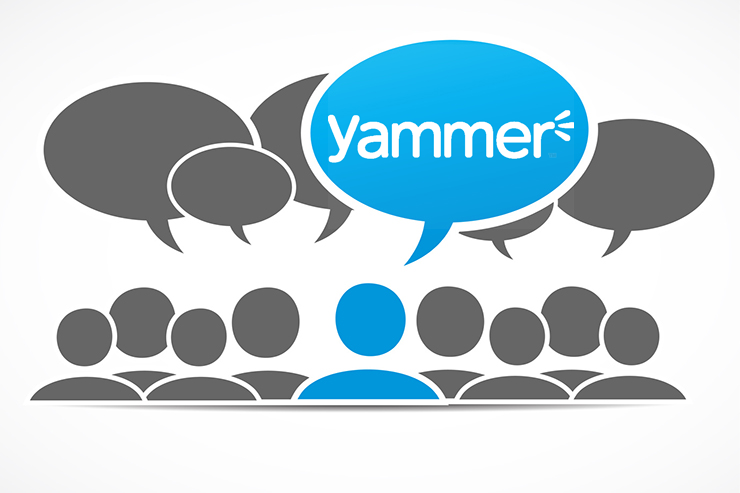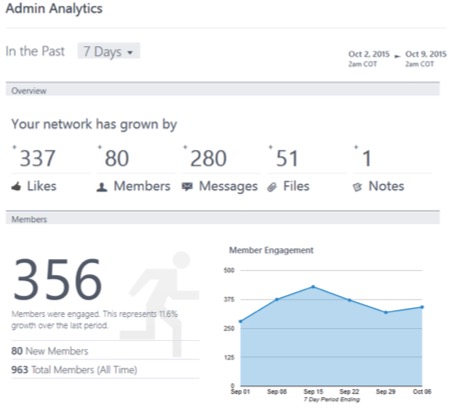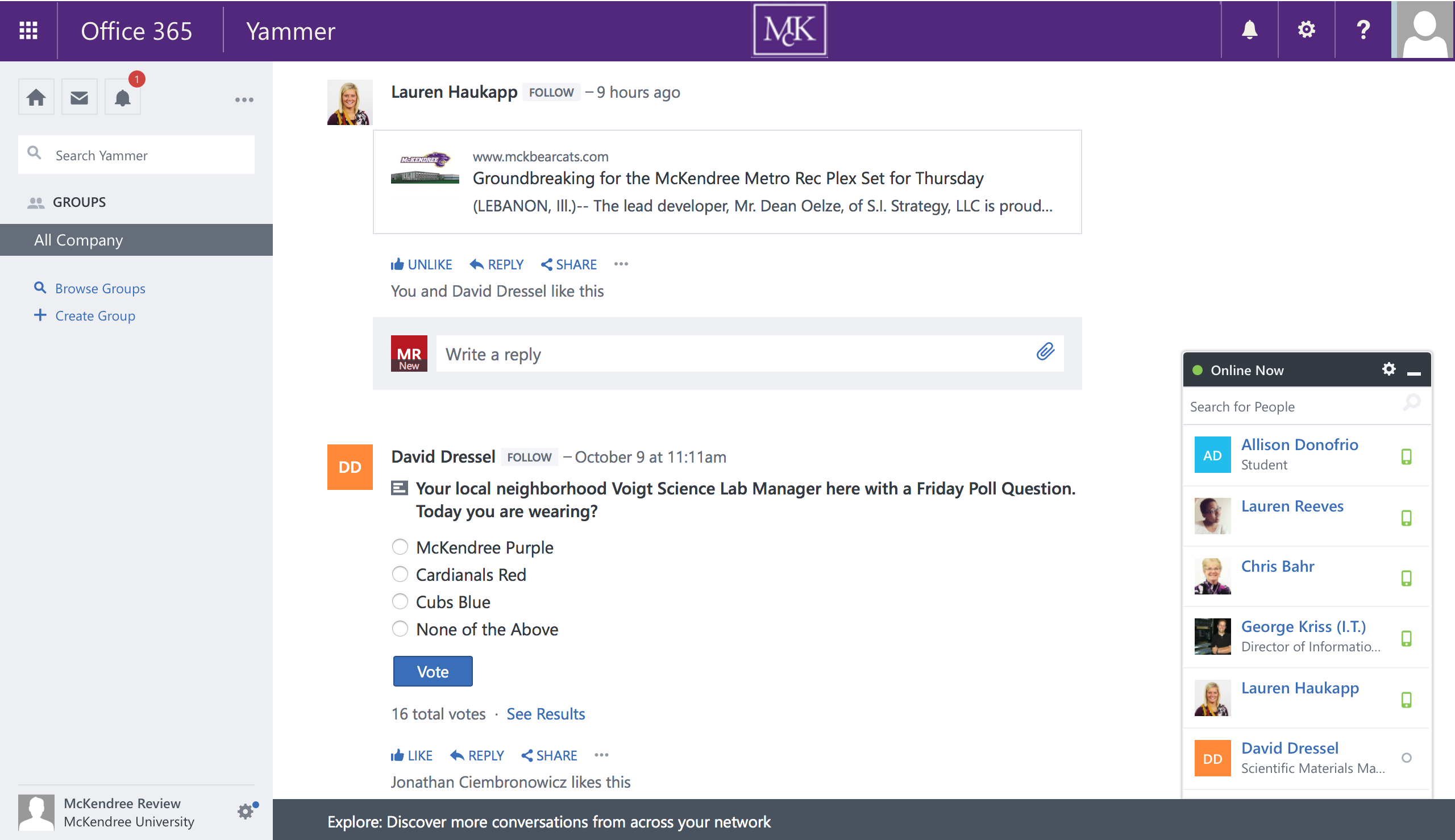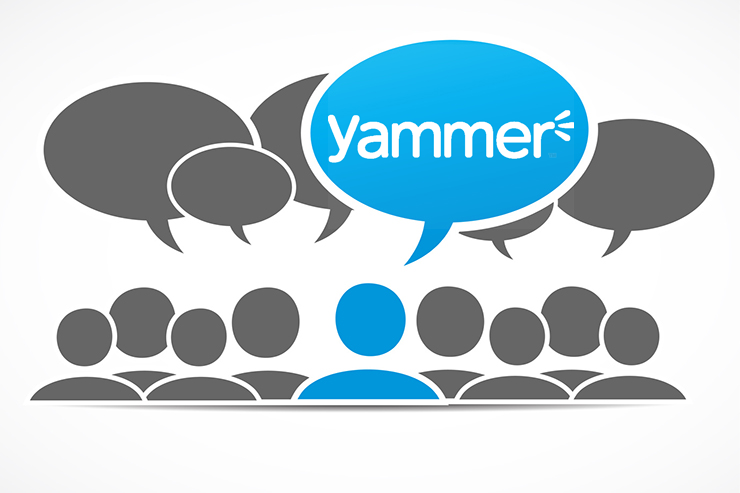
BY ANNA BELMONTE
Staff Writer

Join groups. Get connected. Build yet another Facebook-like community. It will replace email; it will make Academia easier; it will keep you informed.
We have been hearing a lot about Yammer, that McKendree made the switch from email to social media and that students and faculty should use it. While there is a lot of support for the transition, there is also prevailing dissent in the campus community. Some people just don’t want something new, and they don’t like hearing that change is a must.
So what is the big deal? What opinions about Yammer are circulating campus, and why do people feel the way they do? What is all the yammer about?
Let’s explore the issues that sprouted Yammer and the potential it unlocks. We will also look at the good, the bad and the ugly of transitioning to Yammer and determine what we, the campus community, can do to move forwards.
email, email, everywhere
In previous years, McKendree sent emails to convey important information, announcements, reminders, events and academic and social opportunities. The school relied on sending these mass emails to communicate with the entire student body.
Eventually, complaints surfaced about the enormous amount of emails students were getting.
“Even…engaged students said they just received too many emails from too many people, and it was overwhelming,” says Dr. Tami Eggleston, Associate Dean and Professor of Psychology.
In the five years Assistant Professor of Sociology, Dr. Stephen Hagan, has taught with McKendree, he has noticed that students do not like using email, that they get too much of it and that they lack email etiquette.
“Every professor can tell you that students don’t answer email very well,” Hagan says.
When the student government picked up on the issue, they found that students increasingly ignored university emails and chose only to go to the events that teachers and coaches required of them. It seemed that the student body on a whole responded less and less to the massive amounts of messages in their inboxes, and student attendance to campus events declined.
Realizing the negative impact these mass emails were having on the campus community, the student government brought these concerns to Information Technology.
According to Director of Information Technology, George Kriss, student government proposed that the school stop sending overwhelming amounts of email and instead find another method to communicate, something more aligned with social media.
The idea was to transition to an easily navigable and accessible site that would allow messaging features comparable to email. Because of the rising complaints about email, an entirely new alternative became necessary.
Assistant Professor of English, Dr. Joy Santee, emphasizes that “there has to be a connection that goes beyond an email to 2000 people.”
the alternative
The culmination of student and staff complaints as well as the initiative of the student government resulted in the university losing its ability to send out mass emails to students. At the same time, the school moved to using Office 365, which came with a built-in social media component that became the obvious substitute to email: Yammer.
Yammer was the golden solution that would take the load off students’ mailboxes and make information mainstream and centralized. When it was first proposed, students found that Yammer did a lot more than the current system at that time; it seemed to solve the problem above and beyond what student government had requested.
IT had been discussing the transition to Yammer with student government since last year, according to Kriss, and began testing with it six months ago. When Yammer debuted as the alternative to email, however, the university community became reluctant to adopt it.
During the first couple weeks before the 2015 fall semester began, IT started laying Yammer out and pushing the McKendree community to use it.
When emails were stopped, Athletics Corporate Relations and Promotions Coordinator, Ashlyn Beasley, grew concerned about steering from email to Yammer and how it might affect getting information about the athletic department out.
“I was a little skeptical about it at first,” she says, “but then kind of dove more into it.”
Not everyone caught on so quickly. For many it was, and still is, a struggle to make the transition.
“[Students, faculty and staff] didn’t know what to do with it,” says Kriss. “I think it’s just new. People aren’t really sure how to use it, and it’s just gonna take time to roll out.”
what Yammer can do
The Yammer network, during the week of October 2, was shown by Admin Analytics to have grown by 80 members. This makes a total of 963 members, almost a third of whom were active in that single week. Also from October 2-9, Yammer saw 280 messages, 337 likes and 51 files. These numbers indicate over an 11% growth in Yammer users and content over the week.
 Though McKendree adopted Yammer a mere four weeks ago, nearly 2000 messages have been shared among faculty, staff and students in 85 groups. 36 of these groups were active in that single week.
Though McKendree adopted Yammer a mere four weeks ago, nearly 2000 messages have been shared among faculty, staff and students in 85 groups. 36 of these groups were active in that single week.
Kriss illustrates the rapid growth of Yammer on campus by pointing out that Facebook took four years to become popular. “We’ve only been using Yammer for four weeks. In the course of four weeks, we have almost a thousand users.” He says, “To me, that is very good adoption rate.”
What have these 963 members found that some of Yammer’s skeptics have missed?
A big feature is that the Yammer profile is very customizable. Users can tailor what they are interested in by joining select groups and muting notifications to groups they are not interested in. This, of course, was a complaint back when emails from every group and organization would be sent out to everyone.
According to Kriss, students would get 20 or 30 emails a day from organizations and events they did not care about. This leads to the problem of students deleting everything they get. Kriss says, “You just delete faster. You miss stuff. This whole system is to keep you from missing important stuff.”
Yammer provides a more connected community, including features that surpass emailing capabilities. “It’s in a format that everyone is familiar with,” says Educational Technology Specialist, Keri Hemker. “But it’s just for McKendree; it’s just for our students, staff and faculty….”
Yammer is another way to accomplish goals, says Santee, and in a way that allows students to maintain control over their participation. They can join and leave groups when they want.
Whereas email unrestrictedly fills people’s inboxes with messages that they are largely uninterested in, Yammer poses a social media style alternative that allows users to create and join private or public groups, collaborate easily on team projects, send notes and work on group documents from different locations.
“Besides the files, you can also share photos and videos,” says Hemker. These features, she says, allows students to present their ideas verbally via video and upload it to Yammer for peers and instructors to use in collaborating during a class project. “We’re trying to utilize that in our online classes,” Hemker says.
IT offers training sessions and postings on how to better use Yammer and make posts interesting and catchy. The training aims to help people easily pick up on Yammer.
Using IT as a resource to educate her on how to use Yammer, Beasley “was able to take reins of it and be able to transform it and help [the athletics department] reach out….”
Kriss urges people to take advantage of these opportunities and learn about them. He also suggests that people only need a few minutes out of their day to really sit down and learn the ins and outs of Yammer. One way to learn more is to join the Yammer 101 group.
“Think of how much time you’ll save,” Kriss says. “It’s done automatically through Yammer. It’s a super slick system.”

Santee suggests that Yammer can be taken further than connecting and collaborating with the campus community. Faculty can use groups to document what students in their classes and in their division are accomplishing. Attaching documents and other resources to a class group would essentially create an online archive students and faculty alike can refer to in the future.
In this way, says Santee, faculty could use Yammer groups to market the school’s academic programs. This could mean students considering changing their major can view what students within different majors have accomplished, a virtual portfolio for the academic program.
Beasley says she has been able to reach out to more people, hitting more than one target market by sharing information about the athletic department to different Yammer pages.
“It’s kind of a way to pull people in to check out our student athletes and our coaches and how well they’re doing at their particular events,” she says.
Santee also points out that students could use the technology to enhance their own personal development as well. Many corporations today are using Yammer for interpersonal communication, and being familiarized to different mediums early could serve as a springboard for McKendree students beyond their education.
As Eggleston says, “The possibilities are endless.”
the good, the bad and the ugly: email vs. Yammer
But what are people saying? What more is there to say about Yammer than has already been proposed by student government and rolled out by IT?
One issue is that students are simply reluctant to voluntarily participate in school events and activities, whether through email or Yammer. The demands on their time with checking Yammer, posting and making connections seem to not be worth the effort. If it’s not required, it won’t happen.
As Hagan frankly says: “The problem with Yammer is…that students just don’t want to do things.”
Because Yammer is seen by some students and faculty to be an extraneous and time-consuming alternative, there is a widespread desire to go back to using email. The campus community is already familiar with email, and they don’t want to take the time to change.
This view begs the question: was email more effective than Yammer?
Many would say, probably not, but email does have its value. While students viewed the mass emailing as a nuisance, some faculty believe constantly sorting through email is a useful skill.
“My take is that we shouldn’t have [adopted] Yammer,” says Hagan, “because students have to learn that, even though they don’t like to check email, that they have to check it. That this is the world they’re going into.”
Hagan points out that if you ask faculty, they’ll report having the same email issues that students were having. The Sociology professor accepts it as part of the job.
“I teach future police officers a lot,” he emphasizes. “They’ve got to check email.”
With Yammer now in the equation, concerns of this nature heighten.
“My worry is that we are doing a cultural shift,” says Hagan. “Students already don’t like to check email, and we’re basically caving to that….” He goes on to explain that the school needs to do a better job training students to handle email properly. This means having good email etiquette as well as discernment when sorting through large quantities of email.
Debating whether or not email is preferable to Yammer does not solve the deficit in communication, however. The campus community is stuck in a place where they don’t get information in their email inboxes, and they don’t get it on Yammer either.
Hagan also voices concern that Yammer allows people to isolate themselves. Because people get to choose what clubs and organizations they see posts from, they may begin to academically and socially cut themselves off from outside influences beyond their scope of interest.
“Academia is about expanding our boundaries,” says Hagan. “Part of the liberal arts education is about expanding our boundaries.” He asserts that, by restricting ourselves to only the clubs and organizations students are currently interested in, they could be doing themselves a great disservice. “We’re basically not following the philosophy of the liberal arts education.”
Unless students seek out groups on Yammer and make an effort to join groups that could open opportunities for them in the future, their college experience will be greatly inhibited. They will not be opening themselves to new opportunities or exposing themselves to potentially life-changing experiences.
“This is one of the biggest growth periods of your life,” Hagan emphasizes. “You don’t fully know what you’re interested in yet.”
Hagan realizes that students sometimes don’t know what is in their best interests academically and that they need to be open to new things as a part of their educational growth. “They don’t realize how much they’re still growing,” he says, “and how much we constantly still grow.”
Will Yammer help with this pursuit of academic growth? The answer depends on individuals.
Here are some opinion quotes, each holding its own truth:
»“We want to build a fantastic, engaged and intellectual campus climate, and communication is an important part of it.” (Eggleston)
»“I feel a responsibility to learn how to use [Yammer], so I can help students learn how to adapt to changing technology.” (Santee)
»“Since it’s similar to Facebook, [people] are able to stay connected.” (Beasley)
»“It’s an easier way for us to collaborate and share. I think people aren’t seeing that aspect of Yammer.” (Kriss)
»“Is the good worth the bad?” (Hagan)
why such mixed responses?
“You can’t affect change if there’s no buy-in.” Hagan, like many others, realizes there is a deficit in communication because of the general lack of interest in Yammer. Students who aren’t interested in joining simply will not get any information. Hagan says, “That’s the struggle we’re dealing with right now.”
Why are some students, faculty and staff so reluctant to make the change?
“People could always fall back on email, because they knew where to go to get it,” says Kriss. The fact that Yammer is new and has to be sought out and engaged in makes it all the more likely to go by the wayside. Students already have to check their email; do they really want to add something unfamiliar on top of that?
However, the problem isn’t because the campus community would prefer reverting to mass emails again. The frustrations of emailing were so great that, last year, after the student government asked for an alternative communication method, the response to Yammer seemed to indicate hands-down that the social media site would be preferable.
Again, what is all this about?
People just aren’t buying it. It’s a simple explanation highlighting the apathy on the part of some of the campus community to extend the effort of getting involved on Yammer.
On the other hand, Hagan believes the issue resides with implementation. If students are faced with something entirely new that requires their attention and active participation, they will not do it. Even offering the Yammer 101 group and other instruction doesn’t seem to be active enough.
“The focus is then on the student to seek [instruction] out,” Hagan says. “And they won’t….We’ve got to figure out an active method to make that happen.”
Part of the general reluctancy to make the transition from email to Yammer may stem from the difficulty of change in general. Not everyone takes well to doing things differently, and it is a fact that change takes time.
As Eggleston says, “We are in the middle of a change, and change is hard.”
what can we do to move forwards?
Since change has already been made and must be adapted to, the McKendree community would do well to consider it in a different light.
Kriss offers the idea that “if Yammer is constantly in our mind, people will get used to it; it’ll be better than email. We just always forget about it.”
Rather than viewing Yammer as a huge imposition, something we have to remember to check, maybe we can try another take on it. We can think of it as a way to expand our horizons and an easy but active way for us to open opportunities for ourselves. If nothing else, we will at least learn how to use Yammer, which may be of service in the professional world.
Kriss strongly urges the campus community to make an effort to use Yammer, especially through the convenient mobile app. “Download it, start posting, find groups, follow people,” he says, “and you’re gonna get sucked in and involved real quick.”
While students, faculty and staff are still being urged to join the Yammer community and explore the outlets it offers, IT gladly reports that people are in fact catching on and becoming engaged.
“We have a lot of people using it,” says Kriss. “The people that are using it…once they started getting into it, they love it.”
“I think it says a lot about where McKendree is going,” says Beasley, “and once students catch on to it, I think they’re going to realize that they’d rather have [Yammer]….”
But catching on isn’t easy or desirable for some people. Like with any new shift in technology, there will be objectors. Widespread user-ship doesn’t happen overnight.
Hagan is skeptical about the time it will take to get everyone on campus involved. “If Yammer is to work, and it might, then we have to give it a year, maybe two years, maybe even four years….Because buy-in does take time,” he says. “And that’s simply [a] social fact.”
Beasley suggests that students and faculty should at least check Yammer out. Even if they don’t want to follow a lot of groups, they should at least use Yammer for their class work, to connect with classmates and teachers.
If interested in learning more, Beasley recommends going to IT for help. She says that some people, even those in higher positions in the university, just don’t understand the new technology.
Hagan believes Yammer shouldn’t be relied on entirely, that email should still be in steady use.
“We can still send emails, of course,” says Eggleston, “but they need to be for smaller groups and more focused emails.” When sending out emails, the sender needs to consider who they are reaching and for what purpose. Too often in the past, hundreds of people received nonsensical emails about things that did not concern them.
“We need to carefully think who needs our emails,” says Eggleston.
In making the not-so-steady leap from email to social media, Hagan recommends that Yammer should have been phased in instead. The lack of Yammer users may simply be because Yammer was dropped onto everyone’s plates at once, and emails were at the same time stifled, resulting in a sudden lack of information.
While coming on too suddenly to be easily assimilated into the campus culture, Yammer cannot be gotten rid of. Not only would it be unwise to discard it without granting the campus community time to catch on to it, but the school could be missing out on an avenue that could drastically change the future of campus communications.
To support the transition to Yammer, IT has created the Yambassador Award. This title is awarded to people who use Yammer to their advantage, who really make something catchy and special of Yammer.
There is also a giveaway once the user total reaches a thousand, and when user-ship reaches 1828, the prize gets even better.
While prizes are incentives to get onboard with Yammer, Hagan suggests that there should be an overriding reason: our education.
“Buy in to Yammer and go to [campus events],” he says, “because it is a part of your education. You don’t think of it as part of your education. I guarantee you that it is….”
Involvement in education was the ultimate goal of sending all those emails, and to make involvement easier, it has become the goal of Yammer.
As Eggleston honestly points out, “[We] don’t really know what it can or will do if we don’t explore it.”
